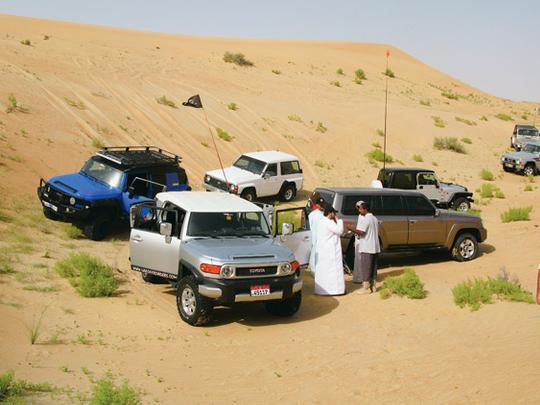
If the idea of camping in the desert with your family appeals but you've no experience of desert driving, don't be tempted to simply throw a tent and a coolbox into the back of your 4x4 and head off aimlessly into the wild yellow yonder for the first time. It will all end in tears, and quite probably a very large repair bill.
Driving in the desert takes practice — it's an acquired skill — and the ability to drive across a sand parking lot in Jebel Ali will not be of any help to you when you are buried up to your axles 15 kilometres from the nearest road, with a burnt-out clutch, no mobile reception, and no water for your children to drink.
The best way to learn to drive in the desert, and to enjoy doing so safely, is to join an off-roading club, where you can follow experienced club members leading novice trips into the desert. Any off-roading group that takes safety seriously will have rules and guidelines about ‘must have' equipment, which members carry in their vehicles at all times, and you'll do well to heed their advice. There's a reason why they'll insist you carry certain items — they've all needed them at some time.
Get the right gear
Ask members where to buy proper ropes and safety-rated shackles, not the yellow string fitted with flimsy hooks sold in corner shops as ‘tow ropes'. Those will break the first time they are used in the sand, at the very least smashing � into your car and, worst case, killing someone. If you don't respect the desert and do things as safely as possible, you'll get hurt.
Does your car have tow hitches fitted? Not the screw-in coat hanger designed to temporarily keep your car restrained on the back of a trailer, but proper, beefed-up off-road tow hitches, secured to the chassis with high-tensile bolts. If not, you shouldn't even be venturing off the tarmac. Flimsy hitches break, and that way nasty injuries happen.
Speak to club members about where to get these hitches fitted, and about jacking boards and ratchet straps, which basic tools you'll need to carry, where to buy ‘fishing pole' flags (so your car can be seen if it's stopped on the other side of a crest) and all the other things which, at first, might seem alien to you but are all needed to ensure everybody's safety.
Having equipped your car with the right devices and removed all the low-hanging plastic spoilers, lights and running boards before Mother Nature does it for you in the sand, you're ready to tackle the Desert Challenge, right? Wrong. Have you checked your vehicle's coolant, brake fluid, power steering fluid and brake pads? Inspected your tyres for nicks and damage? Is the spare tyre in good condition and fully inflated, and is there water in the washer bottle? Are the bonnet and rear door latches in good condition and properly adjusted? You'd be amazed at the damage a flailing bonnet can do to a windscreen, and at how difficult it can be to clean your front seats afterwards.
If you've no prior sand driving experience, what you are now ready for is a couple of hours spent in gently rolling dunes, sandwiched between two experienced drivers who will patiently pull you out every time you get stuck. And you will get stuck, repeatedly.
This doesn't mean you're a bad driver — it simply means you have no idea what you are doing when driving in the desert — and the only way to improve is to make novice mistakes and learn from them.
Keep smiling
And try to remember rule number one of desert driving — maintain a sense of humour and laugh at yourself every time you have to ask for help, because nobody wants to assist a grumpy driver. It's probably best if on these first few trips into the sand, you don't take your family along for the ride. You'll find making mistakes is a lot less irksome when you don't have a frustrated, captive audience criticising your every move.
Having learned the basics over a few weekends, you'll already have befriended a few club members (you know — the ones who towed you out all the time) and they'll be able to tell you about any upcoming social camp-outs.
So, with a few hours experience under your wheels, the right equipment in your car and an appreciation for the safety aspects of off-roading, now is the time to load your family, coolbox and tent into the 4x4, secure them correctly using ratchet straps (not the kids, just the tent and coolbox) and head for the sand hills. Where you will get stuck, to their amusement. But at least you'll be laughing with them.












